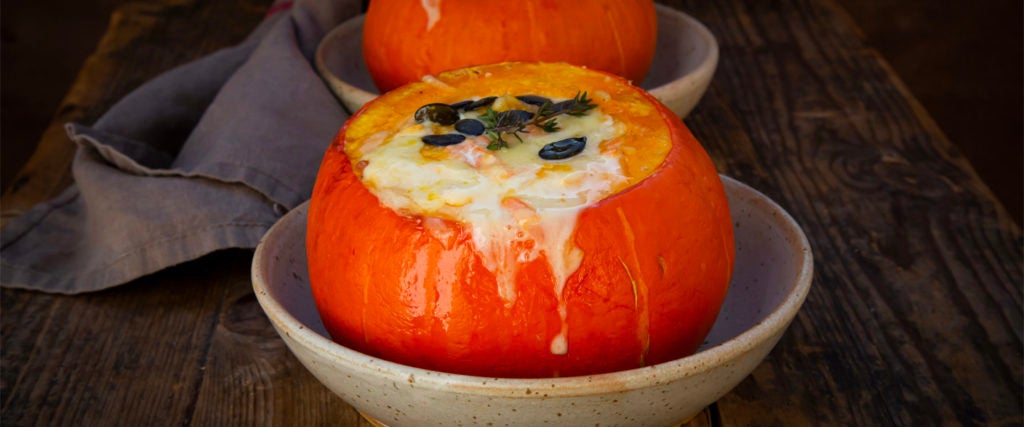America really, really pretends to love pumpkins.
Every October, as the autumn chill begins its descent and leaves begin to fall, it happens: A veritable onslaught of pumpkins fills up the sidewalks outside of grocery stores and farmers markets. There they sit, gleaming orange and mottled green and even creamy white, ready to be loved and consumed.
And every year, tragedy befalls these gregarious squash. Nearly 2 billion pounds of pumpkins are harvested each year in the U.S. Of that, maybe a fifth is turned into edible pumpkin (such as canned puree). The vast majority, meanwhile, are merely purchased as Halloween decor, carved and left to rot until they mold and collapse.
Americans love pumpkin-flavored stuff. We do not like eating pumpkin, unless it’s in pie form. This is truly appalling given the sheer amount of food waste in this country.
And to think, we could reverse course simply by learning to love the pumpkin as a foodstuff again. Easier said than done, maybe, in a world where people get cooking amnesia when presented with a pumpkin. Butternut squash, beloved in soup, curries and Trader Joe’s mac-and-cheese, doesn’t seem to have a publicity problem. But make it round and large, and all of a sudden we’re content to merely let it decay after whittling a face into it?
Nón, as the French say.
Our Gallic allies across the pond have a very different take on pumpkin, especially in Lyon, the food capital of France. I recall the very first time I saw a stuffed baked pumpkin, in a 2014 episode of the late Tony Bourdain’s show Parts Unknown. In it, we see Bourdain hanging out with world-renowned chef Daniel Boulud at his family’s modest farmhouse in Lyon, as they gather for a big feast of sausages, farm-grown vegetables, cheese and the centerpiece: a magnificent orange pumpkin, stuffed with country bread, cheese, bacon, mushrooms and cream, roasted slowly in the oven until it’s mahogany-hued and tender all the way through.
My God, I thought. This is so much better than a Jack-o’-lantern.
In fact, the dish is so simple that you basically don’t need a recipe at all. The most important factor is buying the sweetest, most flavorful pumpkin you can find, and that means avoiding huge orange carving pumpkins (often the “Howden” varietal) and seeking smaller pumpkins, such as the “Sugar Pie” or the red-hued “Cinderella” types. If you’re like me and you buy medium-sized pumpkins for October decorations around the house, sans carving, odds are they’ll stay intact and edible for weeks.
The cooking prep should be easy for anyone who’s ever carved a pumpkin: You cut out the top, scoop out the guts and seeds (which are delicious as a roasted garnish) and then par-bake in the oven at 350 degrees Fahrenheit. Make sure you carefully oil and season the inside generously with salt and pepper, which will do wonders for the final dish.
As the pumpkin bakes (about an hour, or until it just starts to soften), you can prep the filling. Imagine you’re making Thanksgiving stuffing; either way, the ingredients can be improvised. The version from Serious Eats’ Sasha Marx focuses on a filling of bread, roasted kabocha squash and a sauté of mushrooms and kale, all layered with cheese and cream. YouTube favorite Chef John, meanwhile, has a meatier version full of cuts of seared pork, braised inside the pumpkin until tender. Both recipes flavor the pumpkin’s exterior with a sweet-savory glaze near the end of baking, which makes for an even, glistening color.
As for me, I’m on the hunt for a small white Casper pumpkin to fill with a mix of Thanksgiving stuffing, Gruyere cheese, sausage and root vegetables, soaked in spiced cream and a fistful of autumn herbs. With any luck, the entire pumpkin will get eaten, with just the hard stem left behind.
Some 300 years ago, Native Americans introduced their beloved pumpkin to colonists and taught them how to use the entire plant. The least we can do today to honor our favorite seasonal squash is treat it with a bit more reverence and save it from a slow death on a concrete stoop — and thankfully, we’ve got a tradition from France to set things right.

